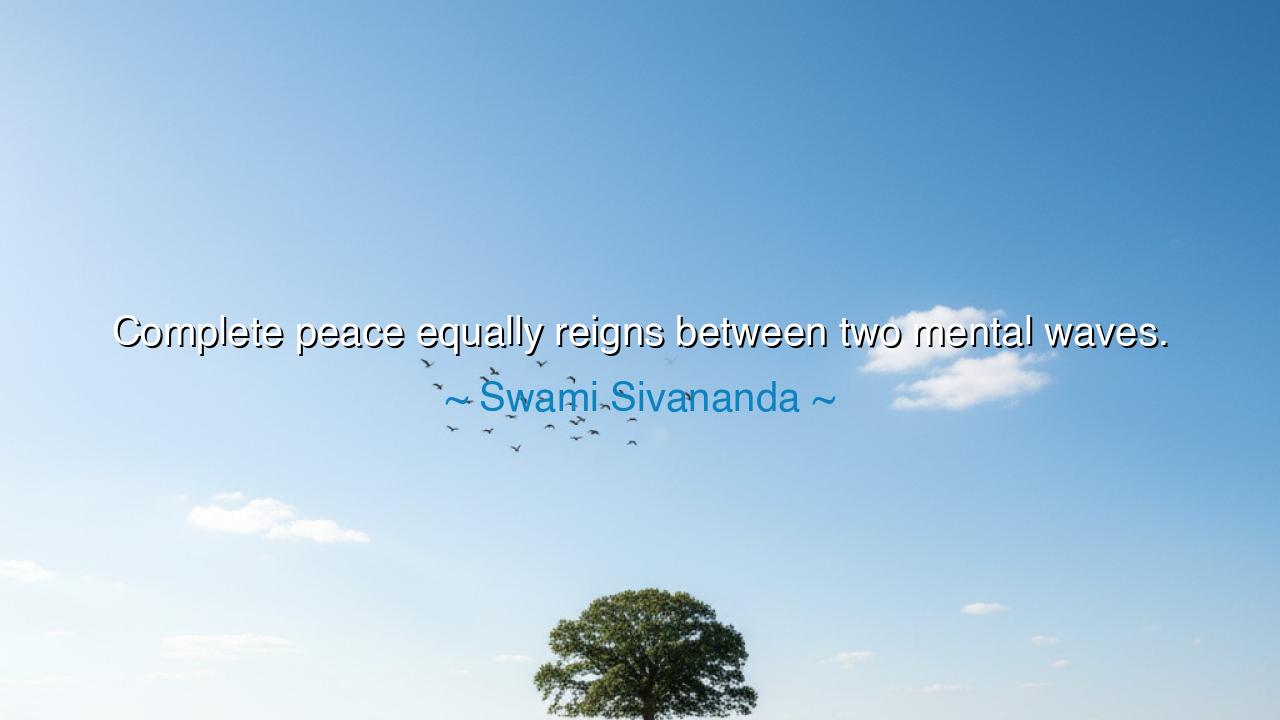
Complete peace equally reigns between two mental waves.






The words of Swami Sivananda — “Complete peace equally reigns between two mental waves.” — are not mere poetry, but a revelation drawn from the depths of yogic wisdom. In them lies the secret of the mind: that its constant churning, its ceaseless flow of thought, is like the ocean stirred by storm winds. Yet just as the ocean has moments of stillness between the rising and falling of each wave, so too the mind has intervals of silence between its endless streams of thought. And in those intervals — brief, subtle, hidden — abides the eternal kingdom of peace.
The ancients often likened the human mind to water. When disturbed, it reflects nothing clearly, scattering the light of the moon into a thousand ripples. But when stilled, it becomes a mirror, flawless and serene, reflecting the truth of the universe. Swami Sivananda points us toward that stillness. He teaches that the mind need not be conquered by force, nor silenced by despair. Instead, by becoming aware of the spaces between mental waves, we may glimpse the eternal calm that is always present, waiting beneath the surface.
History gives us examples of those who mastered this truth. The great sage Ramana Maharshi sat in silence for years upon Arunachala, his mind so still that seekers from all over the world came to him simply to experience the radiance of his presence. He spoke little, yet those near him felt the power of his peace — the vast stillness that lay between his thoughts, untouched by turmoil. His life shows us that the kingdom Sivananda describes is not imaginary; it is accessible, here and now, if one dares to look within.
Even outside the realm of saints and sages, the same truth appears. Consider the soldier on the battlefield who, in the brief pause between two clashes, looks to the sky and feels for a moment the serenity of existence beyond war. Or the artist who, between two brushstrokes, enters a stillness so profound that the work seems to paint itself. These moments are glimpses of the same reality: that peace is not absent from the storm, but hidden between its surges, waiting to be recognized.
Yet this teaching demands discipline. For the ordinary man, thoughts rush endlessly, one wave crashing upon the next. To glimpse the silence between them requires practice — meditation, prayer, breath awareness, stillness of body. With these practices, the intervals grow wider, the silence more profound, until one day the seeker awakens to the truth: that the self is not the waves, but the ocean itself. The waves rise and fall, but the ocean remains vast, calm, eternal.
The lesson is clear: do not be deceived by the noise of the mind. Thoughts are not chains; they are passing waves. Between them lies a doorway to the infinite. Seek that doorway. Guard it. Step into it whenever you can. For in that sacred space dwells the peace you have sought in possessions, in relationships, in ambitions, yet never found. It was always within you, between the waves.
Practical actions follow. Begin by watching your breath, for between inhalation and exhalation there is also a pause, a stillness where life itself whispers. In meditation, observe your thoughts, and when one fades before another begins, slip into the quiet that appears. Throughout your day, pause between tasks, between words, between steps, and taste the silence that dwells there. With practice, the peace that once seemed fleeting will become your constant companion.
So remember, child of tomorrow: you are not bound to the storm of the mind. You are the witness, the ocean, the stillness. The waves will rise and fall, but between them reigns a peace complete, unshakable, eternal. Seek it not outside, but within, and you will find the truth that sages like Swami Sivananda sought to pass down — that in silence, in stillness, in the pause between thoughts, lies the key to freedom.






AAdministratorAdministrator
Welcome, honored guests. Please leave a comment, we will respond soon